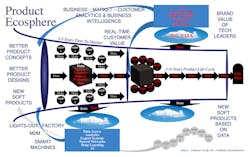Download the PDF of this article.
The definition and design of products, and the level of automation at the factories that turn out products, will be transformed across commercial, consumer, and medical industries over the next 20 years. The sooner companies figure out an initial systematic approach to enable appropriate two-way communication between the product and the factory that makes it—one that can be continuously renewed as the Industrial Internet (IIoT) and Internet of Things (IoT) and their numerous protocols head toward standardization—the better off they will be.
An analogous transformation will occur in the marketplace and customer environments. Products will continuously interact with other products in their domain and with the environment around them. Products will “know” when to start, stop, speed up, slowdown, ask for help, and when to send messages of reassurance. Other products within their domain will react to this data, thus creating an ecosphere. Ecospheres in “super domains” will then begin to react to and interact with each other. As deep learning and AI come of age, super domains will approach self-governing.
Retrofitting products in an ad hoc manner to keep pace with the changing internet will be quite expensive. The IoT is a system-level feature and will be best implemented if it is designed-in to product families as a feature of their architecture, subassemblies, and components. The marketplace will sort out systematic vs. ad hoc very quickly. Once a company’s product has been sorted out by users, it becomes quite difficult to regain market share. Remember Blackberry, a former market leader that didn’t keep up with the pace of change?
Design For X = IIoT & IoT: First there was Design for Assembly, then came Design for Manufacture. More recently there have been Design for Environment and Design for Disassembly & Recyclability. Design for IIoT & IoT (DFI2) is a new member of the Design for X (DFX) family of principled design approaches that has steadily evolved since the 1960s.
The bulk of the DFI2 responsibility will initially fall to product development. Today’s internet technologies are developed outside most manufacturers, brought in-house, and then designed-in to products. A few years from now, R&D and Advanced Development will get more engaged as next-gen sensors move from lab to industry. DFI2 will then become an end-to-end company process.
Design for IIoT: Today, Product Lifecycle Management (PLM) systems capture the lion’s share of product and process design and development data. Most of this data remains with manufacturers and OEMs. As large data repositories and the analytics applied to these repositories make it possible to statistically correlate design to performance, much of this data will begin to accompany the product to the marketplace. Companies will have to make hard choices, just as they did when software-enabled products hit the marketplace two decades ago. Will IoT benefits be given away, as so much software was back when?
Design for IoT: What is really new and very much in its infancy are fully “sensorized products” that are “alive” in their ecospheres in many ways. At some point in their development, they will be “born” and start to “breathe.” They will inhale factory data and external stimuli and exhale results and information. They will respond to the processes, people, and environment around them. As products get close to being released to the market, and then while in transit to the customers who bought them, they will be collecting and transmitting life experiences.
When customers place products into service, the products will already have a baseline performance data set and will then begin logging in-service experiences. Learning will continue right through end-of-life. “Last breath” activities will then be captured, letting companies and customers track compliance to disposal and recyclability regulations.
Product Offspring & Communities: Pre-launch internal product creation data and post-launch external customer and marketplace data will create large, statistically valid data sets that will lead to new products and services. Over time, as experiences across products in a family are logged, a family data set will arise and lead to even more new products and services. The definition of a product as we know it will be forever changed.
About the Author
Bradford Goldense
Contributing Technical Expert
Bradford L. Goldense is founder and president of Goldense Group, Inc. [GGI] (www.goldensegroupinc.com), a consulting, market research, and education firm focused on business and technology management strategies and practices for product creation, development, and commercialization. He has been an adjunct faculty member of the graduate engineering school at Tufts University's Gordon Institute for 19 years. Goldense is a Certified New Product Development Professional [NPDP], a Certified Manufacturing Engineer [CMfgE], a Certified Computer Professional [CCP], and is Certified In Production & Inventory Management [CPIM]. He holds over 200 registered copyrights and is a recognized subject-matter expert, including appearances on PBS and CNBC. He has consulted to over 250 companies and over 750 manufacturing locations on four continents since founding GGI in 1986. Goldense holds an MBA in Accounting from the Cornell Johnson School and a BSCE from Brown University. For more information, please see Brad's LinkedIn profile or visit GGI's home page.



